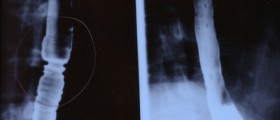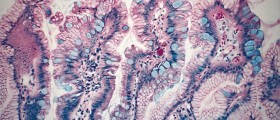
Esophageal cancer (also shortened to EC) is a serious form of esophageal malignancy, often lethal for the patient. First recorded cases of EC go back to the beginning of the 19th century, while the first successful surgical treatment was performed in 1913.
Most cases of esophageal cancer in the United States are adenocarcinomas, responsible for over 50 to 80% of all diagnosed malignant changes in the esophagus. This cancer arises from the cells at the junction of the esophagus and the stomach, known as glandular esophageal cells. The rest of diagnosed esophageal cancers are squamous cells carcinomas (stemming from the cells of the upper part of esophagus) and other subtypes of EC. Who can Develop Esophageal Cancer and what are the Symptoms?
Esophageal cancer is diagnosed in elderly patients, especially those in their 60s and 70s. As the person ages, he or she is more likely to develop this cancer and the risk is about 20 times higher for a person who is older than 65 years of age than for someone younger than that.
Most patients come to their doctor complaining about dysphagia. This condition is actually difficulty in swallowing and patients initially have problems with solid food and as the disease progresses, swallowing liquid becomes a problem as well. This is why many doctors whose patient has been complaining about swallowing problems order endoscopy or barium swallowing study to exclude esophageal carcinoma as a cause of the problem.
In addition to dysphagia, many patients experience weight loss and/or bleeding, pain in the epigastric or retrosternal area or sometimes in certain bones. Bone metastases often cause pain, while unresectable EC can lead to hoarse voice and persisting cough, as well as aspiration of undigested food. Cancer spread to the liver is known to lead to hepatomegaly. If the doctor has found lymphadenopathy in the laterocervical or supraclavicular areas, this usually indicates the spread of EC.
Possible Treatments and Further Care
Adenocarcinoma is more often found and detected in early stages of development, affecting young patients and being more likely to be cured surgically. Some patients therefore can be cured, but the treatments usually last for a long period of time, affecting patient’s quality of life. Regardless the therapy, some patients suffering from EC still experience fatal consequences.
Treatment may be surgical or non-surgical. Experts who believe in surgery usually claim that surgical resection is the only real cure for this malignancy, while experts who are for non-surgical approach believe that EC is incurable disease which cannot be cured with surgery.
After surgery, patients usually stay in hospital for 9 to 14 days. During the first postoperative days patients may develop some respiratory or heart problems. Several days after the surgery, doctors perform a swallow study, looking for some anastomotic leakage. If there is no leakage, patients start oral feeding, but if there is anastomosis leak, they will need some drainage tubes and feeding through jejunostomy.

















Your thoughts on this
Loading...